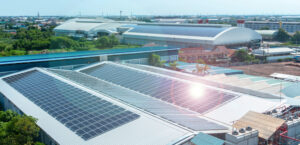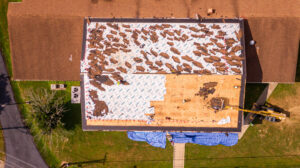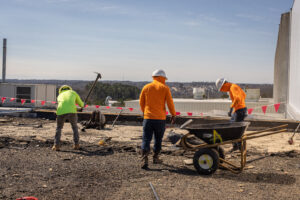
Do you think your commercial building’s roof was damaged during the last storm? There are a few signs of storm damage to look for that’ll definitively give you clear answers.
When heavy winds, tornadoes, and storms hit Knoxville, Chattanooga, and surrounding areas in Tennessee, roofs often falter. When a commercial building’s roof is subject to no regular maintenance and is left unprotected before the rough weather hits, it gets severely damaged most of the time.
But this doesn’t mean you have to replace your roof entirely. There are great commercial roof repair services available today in Nashville that can fix and restore the integrity of a wrecked commercial roof. First, you have to know if your commercial roof needs repair, and you can do this by examining for signs of storm damage.
Different Types of Storm Roof Damage
Wind Damage
Strong winds can cause significant damage to roofing materials. High winds can lift roof shingles, tear off guttering, and even cause structural damage in severe cases. After a storm, look for missing shingles, damaged flashing, or bent gutters as signs of wind damage.
Water Damage
Heavy rain can lead to water infiltration, causing leaks and water damage inside your building. Prolonged exposure to water can weaken the roof structure, leading to more serious issues like mold and structural decay. Signs of water damage include water stains on ceilings, peeling paint, or a musty odor.
Hail Damage
Hail can create punctures or dents in roofing materials, compromising the roof’s integrity. Look for dimpled shingles, damaged vents, or bruised roofing materials after a hailstorm.
Signs of Roof Damage From Wind
- Missing or Damaged Shingles or Panels: High winds can rip off shingles or panels from the roof. Look for missing pieces or ones that are curled, cracked, or damaged.
- Debris Accumulation: After strong winds, debris such as branches, leaves, or even parts of other structures can accumulate on the roof, potentially causing damage.
- Membrane Issues: For roofs with a membrane system, look for signs of blistering, wrinkling, or tearing. Wind can cause these membranes to become loose or damaged.
- Gutter and Downspout Damage: Wind can cause gutters and downspouts to become loose, clogged, or detached, affecting drainage and potentially leading to water damage.
- Flashing Damage: Flashing is used to seal and protect joints in the roofing system. Wind can cause flashing to become loose or detached, leading to leaks.
- Interior Water Stains: Water stains on ceilings or walls inside the building can indicate a leaky roof, possibly due to wind damage.
- Increased Energy Bills: Unexpected increases in heating or cooling costs can be a sign of roof damage, as wind may have created gaps or holes that affect the building’s insulation.
- Visible Dents or Punctures: Inspect the roof for dents, punctures, or other signs of impact, which can be caused by flying debris during high winds.
- Loose Roofing Material: Check for any roofing materials that seem loose or out of place, as wind can weaken the overall structure of the roof.
- Creaking or Unusual Noises: Unusual noises coming from the roof could indicate structural damage or loosening components due to wind.
- Sagging Roof Deck: A sagging appearance in the roof deck can be a sign of underlying damage from wind, water, or debris.
- Granule Loss (for Asphalt Roofs): Look for excessive granule loss in asphalt shingles, which can be a sign of wind damage and aging.
Signs of Roof Damage From Heavy Rain
- Water Leaks and Drips: The most obvious sign of roof damage is water leaking into the building. Look for drips, puddles, or water stains on ceilings and walls.
- Pooling Water: After a rainstorm, check for areas of standing water on the roof. This can indicate poor drainage and can lead to roof material deterioration and leaks.
- Sagging Roof Sections: Heavy rain can cause parts of the roof to sag or bow, indicating potential structural issues or water accumulation.
- Gutter and Drainage Issues: Overflowing or clogged gutters and downspouts can indicate that rainwater isn’t being properly channeled away from the roof.
- Damaged Roof Membrane or Covering: Look for tears, blisters, or punctures in the roof membrane or covering. Heavy rain can exacerbate existing weaknesses.
- Mold and Mildew Growth: Excess moisture from rain can lead to mold and mildew growth, which can be seen or smelled inside the building.
- Interior Water Stains: Water stains on interior ceilings and walls are a clear sign of roof leaks.
- Increased Humidity Inside the Building: If the building feels more humid than usual after heavy rain, it could be due to water intrusion from the roof.
- Corrosion or Rust: Metal components of the roof, such as fasteners and flashing, can corrode or rust due to prolonged exposure to moisture.
- Damaged Flashing: Flashing around vents, chimneys, and roof edges can be damaged by heavy rain, leading to leaks.
- Granule Loss from Asphalt Shingles: Excessive granule loss can occur due to heavy rain, leading to reduced effectiveness of shingles.
- Cracked or Broken Tiles: For tile roofs, heavy rain can exacerbate cracks or breakage.
- Peeling Paint or Wallpaper: Inside the building, peeling paint or wallpaper can be a sign of moisture intrusion from the roof.
- Odors: Musty or damp odors inside the building can indicate that rainwater has penetrated the roof and is causing problems.
Signs of Storm Damage on Roofs Due to Hail
- Dented or Bruised Shingles: Hailstones can leave dents or bruises on asphalt shingles, metal roofs, or tiles. These may not always be visible from the ground.
- Cracked or Broken Tiles: Hail can crack or break clay, slate, or concrete tiles.
- Granule Loss: On asphalt shingles, hail can knock off the granules, exposing the underlying bitumen. This can be seen as bare spots or accumulate in gutters and downspouts.
- Punctures in Roofing Material: Larger hailstones can puncture roofing materials, creating holes or tears.
- Damaged Roof Vents and Skylights: Hail can dent or crack roof vents, skylights, and other roof accessories.
- Split Wood Shingles: Wood shingles can split due to hail impact, often with a brown/orange color at the split and sharp edges.
- Metal Roof Damage: On metal roofs, look for dents or circular patterns where the hail has impacted.
- Gutter and Downspout Dents: Hail can leave dents on gutters and downspouts, indicating potential roof damage.
- Damage to Siding and Windowsills/Casings: While not roof damage per se, damage to these areas can indicate the severity of the hailstorm and suggest potential roof damage.
- Flashing and Chimney Covers: Check for dents or damage to metal flashing and chimney covers.
- Water Leaks or Stains: After a hailstorm, check the attic and interior ceilings and walls for water stains or leaks that may indicate roof damage.
- Excessive Shingle Debris in Gutters: Large amounts of shingle debris in gutters can indicate severe damage.
- Damaged Underlayment or Roof Deck: In severe cases, hail can damage the underlayment or even the roof deck.
- Altered Appearance of Roof: Sometimes, hail damage can alter the overall appearance of the roof, making it look uneven or patchy.
Finding Out that Your Roof is Damaged by a Storm
Depending on the extent of storm damage, the discovery might come as a shock or mere acceptance of the fact that several warning signs were ignored. Typically, a person notices the damage to a roof on the day or after the storm.
If the signs are not visible from the outside, you’ll probably notice them from the inside. If the roof is hit severely and leaking, you might have to move objects to safe areas in the building and cover them.
In these situations, refrain from attempting to inspect and repair the roof by yourself. Because thunderstorms can damage the roof structure, you could put yourself in harm’s way.
Inspecting and repairing commercial roofs is an extensive process that requires specialized tools and expertise. The best thing to do when you see signs of storm damage on the roof of your commercial building is to engage a roofing contractor.
Storm Damage Checklist for Commercial Roofs
 General Inspection
General Inspection
- Safety First: Prioritize safety before starting the inspection.
- Overall Visual Inspection: Use ground-level observation and binoculars for initial assessment.
 Surface of the Roof
Surface of the Roof
- Shingles and Tiles: Look for any signs of damage.
- Flat Roof Surfaces: Check for water pooling and surface irregularities.
- Metal Roofs: Inspect for any dents or displacements.
 Roofing Components
Roofing Components
- Gutters and Downspouts: Ensure they are intact and debris-free.
- Vents and Equipment: Inspect all rooftop installations.
- Flashing: Check the integrity of flashing around protrusions.
 Signs of Water Damage
Signs of Water Damage
- Leaks: Be on the lookout for any water penetration.
- Water Stains: Inspect ceilings and under-roof for stains.
- Insulation: Check for dampness or damage in insulation.
 Structural Aspects
Structural Aspects
- Sagging: Identify any areas where the roof may be sagging.
- Interior Damage: Look for signs of damage inside the building.
- Debris: Clear and note any debris that caused damage.
 Immediate Actions
Immediate Actions
- Temporary Fixes: Apply temporary measures to mitigate further damage.
- Photographic Evidence: Document damage for insurance claims.
 Professional Inspection
Professional Inspection
- Consult a Professional: Engage with experts for an in-depth analysis.
 Follow-Up
Follow-Up
- Insurance Claim: Initiate the claim process with your insurer.
- Schedule Repairs: Plan for repairs as soon as possible.
 Preventive Measures
Preventive Measures
- Regular Maintenance: Implement a schedule for regular roof checks.
If you’ve identified storm damage on your roof, learn How to Cope with Commercial Roof Storm Damage.
Today, Nashville, Knoxville, and Chattanooga, TN, have access to some of the finest business roofing contractors. You can obtain roofing service for emergencies at any time. Let the reputed roofing experts take care of your problem.
24/7 Roofing Services – Solution for Storm-Related Roof Emergencies
Eskola Roofing provides round-the-clock roofing services in Tennessee, offering immediate storm emergency assistance and expert maintenance in Nashville, Knoxville, and Chattanooga, ensuring quick, reliable solutions for commercial buildings. If you are a business owner in need of commercial roof emergency service in Knoxville, we can come there and help you right away. We’ll bring expert equipment, skills and more than 40 years of experience.
Prepare your Commercial Roof for the Next Storm
After repairs to the roof, consider preventive maintenance. The easiest way for commercial building owners to keep the roof in good shape is preventive maintenance practices.
It involves carrying out regular inspections, removing puddles, and removing barriers that would increase the likelihood of storm damage.
Commercial roof maintenance is an ongoing and regular process. Therefore, you need a reputable roofing contractor to assist you.
Eskola provides commercial roofing maintenance plans, which are designed specifically for companies located in Knoxville and Chattanooga.
Regular maintenance of the roof eventually ensures the longevity of your roof and minimizes the risk that could arise from a storm, heavy rain, and other natural weather conditions.
Call our Nashville, Knoxville, or Chattanooga offices, depending on where your building’s located, to get a quick roof inspection today. We can help.






